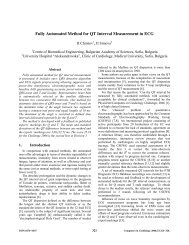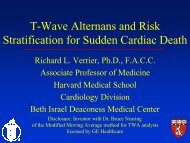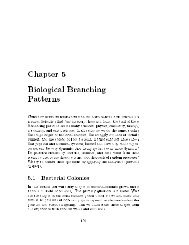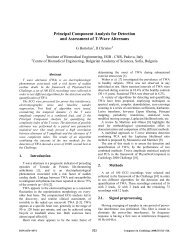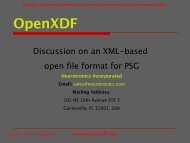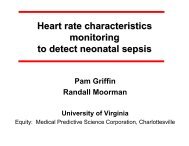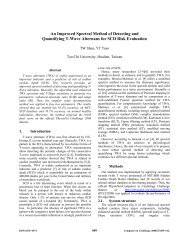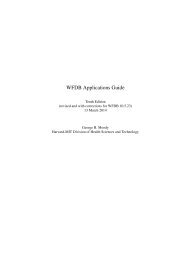Automated QT Interval Analysis on Diagnostic ... - PhysioNet
Automated QT Interval Analysis on Diagnostic ... - PhysioNet
Automated QT Interval Analysis on Diagnostic ... - PhysioNet
Create successful ePaper yourself
Turn your PDF publications into a flip-book with our unique Google optimized e-Paper software.
situati<strong>on</strong>s in which the patterns arise from averaging <strong>on</strong>ly<br />
a small number of beats, such as when, in short ECG<br />
segments, the noise level is not negligible, the heart rate<br />
variability high or many ectopic beats are present. In<br />
those situati<strong>on</strong>s taking the measures <strong>on</strong> the average<br />
patters is of little help unless we are able to increase the<br />
number of beats in the group. Therefore, the use of two<br />
separate patterns possibly increases the number of<br />
recording <strong>on</strong> which effectively using the technique.<br />
Unfortunately, the technique we suggested proved<br />
capable of automatically refining the positi<strong>on</strong>s of Q<br />
<strong>on</strong>sets and T offsets in <strong>on</strong>ly a fracti<strong>on</strong> of the total<br />
recordings (about 87%). When the recordings were highly<br />
corrupted by noise or the initial guess for the end of the T<br />
wave was misplaced, often the algorithm ended up<br />
misleadingly providing an estimate of the end of the P<br />
wave of the following beat (thus furnishing estimates for<br />
the <str<strong>on</strong>g>QT</str<strong>on</strong>g> interval far outside the physiological range).<br />
Obviously, for the sake of the competiti<strong>on</strong>, we could have<br />
substituted all the <str<strong>on</strong>g>QT</str<strong>on</strong>g> we knew were outside the<br />
physiological range (e.g. <str<strong>on</strong>g>QT</str<strong>on</strong>g>500 ms)<br />
with a comm<strong>on</strong> physiologically-reas<strong>on</strong>able value, let’s<br />
say 400 ms. As we verified after the competiti<strong>on</strong> was<br />
ended and the “gold standard” scores published, doing so<br />
our hypothetical score would have been of 44.63 ms,<br />
much closer to what we c<strong>on</strong>sider the true performances of<br />
our algorithm (see previous secti<strong>on</strong>). Nevertheless, we<br />
c<strong>on</strong>sidered that such substituti<strong>on</strong>, meaningful <strong>on</strong>ly for the<br />
competiti<strong>on</strong>, would have been of any scientific interest<br />
and we rather avoided it.<br />
The method we suggested needs surely further work<br />
and a fine tuning. A multi-lead approach might be a<br />
possible improvement: applying the method <strong>on</strong> more than<br />
a lead could help to resolve those situati<strong>on</strong>s in which the<br />
<str<strong>on</strong>g>QT</str<strong>on</strong>g> value computed <strong>on</strong> the lead II was outside the<br />
physiological range. Also, a rough refinement of the<br />
initial guess for “T end” might help.<br />
No matter how the method we proposed scored, we<br />
feel that the overall competiti<strong>on</strong> showed that it might be<br />
possible in the future to accept automated methods am<strong>on</strong>g<br />
those trusted to measure the <str<strong>on</strong>g>QT</str<strong>on</strong>g> interval from ECG<br />
recording, thus also ensuring a higher repeatability of<br />
measurements than today.<br />
Acknowledgements<br />
The authors thank the organizers of the challenge for<br />
the effort shown in organizing the competiti<strong>on</strong>.<br />
References<br />
[1] de Bruyne MC, Hoes AW, Kors JA, Hofman A, van<br />
Bemmel JH, Grobbee DE. Prol<strong>on</strong>ged <str<strong>on</strong>g>QT</str<strong>on</strong>g> interval predicts<br />
cardiac and all-cause mortality in the elderly - The<br />
Rotterdam Study. European Heart Journal 1999;20:278–<br />
284.<br />
[2] M<strong>on</strong>tanez A, Ruskin JN, Hebert PR, Lamas GA,<br />
Hennekens CH. Prol<strong>on</strong>ged <str<strong>on</strong>g>QT</str<strong>on</strong>g>c <str<strong>on</strong>g>Interval</str<strong>on</strong>g> and Risks of Total<br />
and Cardiovascular Mortality and Sudden Death in the<br />
General Populati<strong>on</strong>. Aech Intern Med 2004;164:943-948.<br />
[3] Gittleman IW, Thorner MC, Griffith GC. The Q-T interval<br />
of the electrocardiogram in acute myocarditis in adults,<br />
with autopsy correlati<strong>on</strong>. Am Heart J. 1951;41:78-90.<br />
[4] Lepeschkin E, Surawicz B. The measurement of the Q-T<br />
interval of the electrocardiogram. Circulati<strong>on</strong>;1952;6:378-<br />
388.<br />
[5] Hoffman JIE, Lister G. The implicati<strong>on</strong>s of a relati<strong>on</strong>ship<br />
between prol<strong>on</strong>ged <str<strong>on</strong>g>QT</str<strong>on</strong>g> interval and the Sudden Infant<br />
Death Syndrome. Pediatrics 1999;103:815-817.<br />
[6] Roden DM. Drug-Induced Prol<strong>on</strong>gati<strong>on</strong> of the <str<strong>on</strong>g>QT</str<strong>on</strong>g> <str<strong>on</strong>g>Interval</str<strong>on</strong>g>.<br />
N Engl J Med 2004;350:1013-1022.<br />
[7] Bazett HC. An analysis of the time-relati<strong>on</strong>s of<br />
electrocardiograms. Heart 1920;7:353-370.<br />
[8] Malik M, Färbom P, Batchvarov V, Hnatkova K, Camm<br />
AJ. Relati<strong>on</strong> between <str<strong>on</strong>g>QT</str<strong>on</strong>g> and RR intervals is highly<br />
individual am<strong>on</strong>g healthy subjects: implicati<strong>on</strong>s for heart<br />
rate correcti<strong>on</strong> of the <str<strong>on</strong>g>QT</str<strong>on</strong>g> interval. Heart 2002;87:220-228.<br />
[9] ICH. E14 Clinical Evaluati<strong>on</strong> of <str<strong>on</strong>g>QT</str<strong>on</strong>g>/<str<strong>on</strong>g>QT</str<strong>on</strong>g>c <str<strong>on</strong>g>Interval</str<strong>on</strong>g> Prol<strong>on</strong>gati<strong>on</strong><br />
and Proarrhythmic Potential for N<strong>on</strong>-Antiarrhythmic<br />
Drugs. 2005. http://www.fda.gov/cber/gdlns/iche14qtc.htm<br />
[10] Murray A, McLaughlin NB, Bourke JP, Doig JC, Furniss<br />
SS, Campbell RW. Errors in manual measurement of <str<strong>on</strong>g>QT</str<strong>on</strong>g><br />
intervals. Br. Heart J. 1994;71:386-390.<br />
[11] Badilini F, Mais<strong>on</strong>-Blanche P, Childers R, Coumel P. <str<strong>on</strong>g>QT</str<strong>on</strong>g><br />
interval analysis <strong>on</strong> ambulatory electrocardiogram<br />
recordings: a selective beat averaging approach. Med Biol<br />
Eng Comput. 1999;37:71-9.<br />
[12] Moody GB, Koch H, Steinhoff U. The <strong>PhysioNet</strong> /<br />
Computers in Cardiology Challenge 2006: <str<strong>on</strong>g>QT</str<strong>on</strong>g> <str<strong>on</strong>g>Interval</str<strong>on</strong>g><br />
Measurement. Computers in Cardiology (33) 2006.<br />
[13] Laguna P, Jané R, Bogatell E, Anglada DV.<br />
ECGPUWAVE, freely available from www.physi<strong>on</strong>et.org.<br />
[14] Lepeschkin E, Surawicz B. The measurement of the Q-T<br />
interval of the electrocardiogram. Circulati<strong>on</strong> 1952;6:378-<br />
388.<br />
Address for corresp<strong>on</strong>dence<br />
Roberto Sassi<br />
Dipartimento di Tecnologie dell'Informazi<strong>on</strong>e<br />
Università degli Studi di Milano<br />
via Bramante 65, 26013 Crema (CR) Italy<br />
E-mail address: sassi@dti.unimi.it




